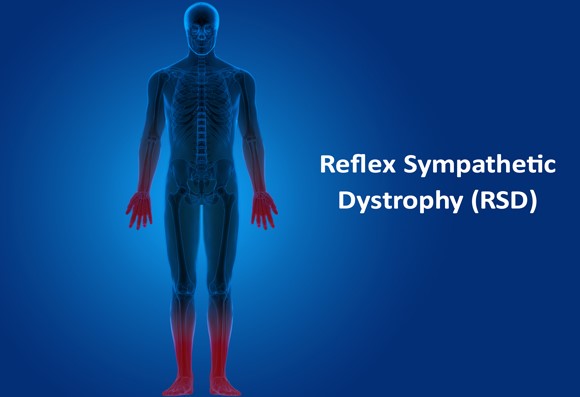Reflex Sympathetic Dystrophy, or RSD, is also known as Complex Regional Pain Syndrome (CRPS). It is estimated that there are between 1.5 and 3 million women, men, and children with Reflex Sympathetic Dystrophy in the United States alone, of which 75% are women. The majority of victims develop the disease in their 30’s and 40’s but it can hit anyone at any age
Reflex Sympathetic Dystrophy, Type I and Type 2, are chronic conditions characterized by burning pain and abnormalities in the sensory, motor and autonomic nervous systems. In most cases, regardless of the site of the injury, the symptoms begin and remain most intense in the most distant extremity. In the initial stages of Reflex Sympathetic Dystrophy Type I and 2, pain and swelling from the injury do not subside but actually intensify, spreading from the site of the injury to other parts of the limb, to the opposite limb or to remote regions of the body.
RSD occurs from over-activity in the sympathetic, or unconscious, nervous system. The sympathetic nervous system is that part of the nervous system that regulates involuntary bodily functions such as increasing heart rate, constricting blood vessels, and increasing blood pressure. Changes in muscles, joints or bones and difficulty moving the joint or limb are hallmarks of the disorder.
Reflex Sympathetic Dystrophy can occur after nerve compression. The National Center for Biotechnology Information found that of patients who reported Reflex Sympathetic Dystrophy Type 2, the more painful RSD, peripheral nerve compression was present in 86% of the patients, with 50% of the patients having single nerve compression, and 50% having multiple nerve compressions. The main function of the peripheral nervous system is to connect the central nervous system to the limbs and organs, essentially serving as a communication relay going back and forth between the brain and the extremities. Today, it has been shown that many Reflex Sympathetic Dystrophy patients can be cured through specialized surgical techniques
It has long been believed that the only surgical option for Reflex Sympathetic Dystrophy is a Sympathectomy. A Sympathectomy is a surgical procedure that destroys nerves in the sympathetic nervous system. This surgical procedure cuts or destroys the sympathetic ganglia, which are collections of nerve cell bodies in clusters along the thoracic or lumbar spinal cord. However what makes Sympathectomies controversial is that they do not address the origin of the problem and only destroy the messenger, the sympathetic ganglia.
The current research found now suggests that the symptoms of Reflex Sympathetic Dystrophy Type 2 result from an injured nerve or nerves. The nerves send normal pain signals that pass through the spinal cord and are then transmitted to the brain. The problems occur because compression of the spinal cord begins to send confusing signals to the brain, as well as to the injured area itself. This compression causes confused signals that interfere with normal blood flow and sensory signals resulting in extreme pain.
Compression of one of the nerves of the spine can cause pain that radiates from the neck, upper back, or lower back to the arms or legs; decreased sensation; numbness and tingling; and muscle weakness. Compression of a spinal nerve can result from a herniated disc, arthritis of the spine, spinal stenosis, or bone spurs. In severe cases, surgery to relieve pressure on the nerve may be necessary.
Some evidence points to nerve entrapment from spinal stenosis as the cause of Reflex Sympathetic Dystrophy Type 2. Spinal stenosis is a narrowing of the spaces in the spine causing compression of nerves and nerve roots.
Spinal stenosis is most effectively treated with minimally invasive endoscopic spine surgery, an approach and procedures pioneered by the Bonati Spine Institute, and which form the foundation of the exclusive patented Bonati Spine Procedures. These procedures utilize small incisions instead of large incisions through skin and soft tissues. A surgeon will insert narrow tubes into the small openings. These tubes, can accommodate surgical instruments and tiny cameras or microscopes. The cameras and microscopes project images onto a screen, which guide surgeons as they perform surgery.
Because it generally causes less trauma to your body, procedures such as the Bonati Spine Procedures offer quicker healing and rehabilitation. These procedures have a sustained success rate of over 98.75% and will help you return to your normal activities. If you are interested in learning if you are a candidate for the Bonati Spine Procedures, please call 855-267-0482 or complete our online contact form here.

